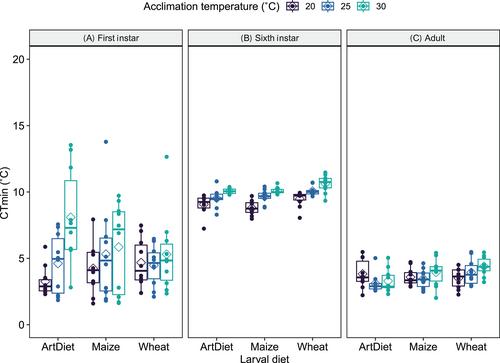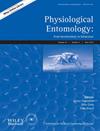Developmental diet, life stage and thermal acclimation affect thermal tolerance of the fall armyworm, Spodoptera frugiperda
IF 1.6
4区 农林科学
Q2 ENTOMOLOGY
引用次数: 0
Abstract
Insect thermal tolerance affects survival and distribution of species but can vary within and between individuals due to the environmental conditions they experience. The fall armyworm (FAW), Spodoptera frugiperda (J. E. Smith) (Lepidoptera: Noctuidae), recently invaded Africa and its local hotspots are associated with weather and crop phenology. We investigated the effects of larval diet (maize plants, wheat plants or chickpea‐based artificial diet), life stages and acclimation temperature on thermal tolerance traits of FAW to explore how these variables might contribute to its presence in the field. First and sixth instar larvae and adults reared on each diet at 25°C were acclimated for 24 h at 20, 25 or 30°C. We then recorded the critical thermal minimum (CTmin) and critical thermal maximum (CTmax) of individuals. Sixth instars had the highest CTmin but the effects of acclimation and diet on this trait depended on the life stage being tested. CTmin of first instars increased with acclimation temperature when fed on an artificial diet, but sixth instars and adults were not affected by acclimation or larval diet. CTmax was lowest among adults but acclimation and diet again had effects that differed between life stages. CTmax of first instars and adults increased with acclimation temperature but not in sixth instars. Sixth instars and adults reared on the artificial diet had the highest CTmax but diet had no effect on first instar CTmax. Our results show the complexity of thermal tolerance across FAW life stages and suggest the need to consider local temperature variation and available dietary resources when predicting their potential distribution.

发育期饮食、生活阶段和热适应对草地贪夜蛾耐热性的影响
昆虫的耐热性影响物种的生存和分布,但由于所经历的环境条件,个体内部和个体之间可能会有所不同。秋粘虫(FAW),草地贪夜蛾(J.E.Smith)(鳞翅目:夜蛾科),最近入侵非洲,其当地热点地区与天气和作物表型有关。我们研究了幼虫日粮(玉米、小麦或鹰嘴豆人工日粮)、生活阶段和驯化温度对FAW耐热性性状的影响,以探讨这些变量如何影响其在田间的存在。每种日粮在25°C下饲养的1龄和6龄幼虫及成虫均适应24小时 h。然后,我们记录了个体的临界热最小值(CTmin)和临界热最大值(CTmax)。6龄具有最高的CTmin,但驯化和饮食对这一特性的影响取决于所测试的生命阶段。人工日粮喂养时,1龄幼虫的CTmin随驯化温度的升高而增加,但6龄和成虫不受驯化或幼虫日粮的影响。CTmax在成年人中最低,但适应和饮食对不同生命阶段的影响不同。1龄和成虫的CTmax随驯化温度的升高而升高,6龄则不升高。人工日粮饲养的6龄和成虫CTmax最高,但日粮对1龄CTmax无影响。我们的研究结果显示了一汽生命阶段耐热性的复杂性,并表明在预测其潜在分布时需要考虑当地温度变化和可用的饮食资源。
本文章由计算机程序翻译,如有差异,请以英文原文为准。
求助全文
约1分钟内获得全文
求助全文
来源期刊

Physiological Entomology
生物-昆虫学
CiteScore
2.80
自引率
6.70%
发文量
21
审稿时长
>12 weeks
期刊介绍:
Physiological Entomology broadly considers “how insects work” and how they are adapted to their environments at all levels from genes and molecules, anatomy and structure, to behaviour and interactions of whole organisms. We publish high quality experiment based papers reporting research on insects and other arthropods as well as occasional reviews. The journal thus has a focus on physiological and experimental approaches to understanding how insects function. The broad subject coverage of the Journal includes, but is not limited to:
-experimental analysis of behaviour-
behavioural physiology and biochemistry-
neurobiology and sensory physiology-
general physiology-
circadian rhythms and photoperiodism-
chemical ecology
 求助内容:
求助内容: 应助结果提醒方式:
应助结果提醒方式:


